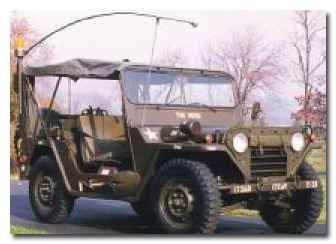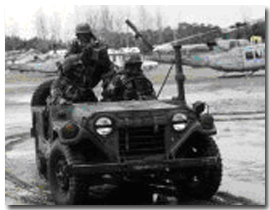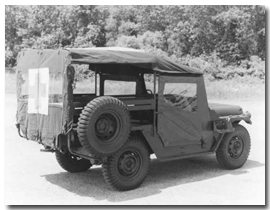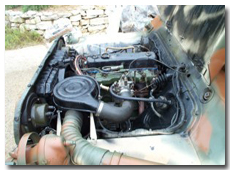 |
Since World War II the US military has relied on the "Jeep" to get it through the mud and to the front line. There were many incarnations of it, the last being the trusty "Mutt" that was first used in Vietnam and only recently retired in the early 1990s. The U.S. Air Force used it as a mode of transport for its important forward air controllers, who helped call in pinpoint air strikes on enemy positions. |
History
| The M151 Mutt (Military Unit Tactical Truck) replaced the M38A1. It was designed by Ford and later built by Kaiser, AM General Corporation, and GM. In 1951 the Ford Motor Company was given a contract to develop a Military Utility Tactical Truck (MUTT) to replace the WWII era MB Jeep and it's descendant the M38. A production contract was awarded in 1960 for the 1st of over 10,000 units that would be used by all US and many foreign military forces. |
|
| Tested and prototyped by Ford through most of the fifties, the M151 MUTT ("Military Unit Tactical Truck") went into production in 1959 and became the principal combat Jeep of the Vietnam era. |
Production of the M151 continued for just a short time when the M151A1 was introduced with modifications to carry heavier loads. In 1969 the M151A2 was introduced to try and correct a serious problem with the suspension that made the M151 unstable and susceptible to roll-over in tight cornering situations due to the central articulation of the suspension arms, the lowering of one wheel relative to the frame would make the wheel move inward, effectively over-steering the vehicle and causing it to abruptly overturn. This was corrected by the integration of an 'A' arm with coil spring to each wheel. The M151 and the M151A1 have the pivots on the inside of the wheel. The M151A2 changed the rear A arms to pivot front to back. This greatly reduced the tendency to roll over during a high speed turn.
|
Additional contributing factors to the tendency to roll over that where suggested was the vehicle having been designed for OFF ROAD USE as its primary mission. The tires used by U.S. and many allied forces, are of the Non-Directional Tread (NDT) type. Simply stated this means there is no specific tread pattern - the tire is made for gripping soft soil or wet unimproved surfaces. Operators of the M151 displayed a propensity for application of civilian automobile handling |
| characteristics in their driving habits but in fact were using a primarily off road vehicle with no tread on the tires. |
The M151A2 was born and was raised in the militia, and it is always ready for the action. Form part of the series of military vehicles 4X4 more versatile of the fact that is had. And must be it, since it manufactures it AM General with their more than 40 military experience years. The M151 series has, as norm equipment, an electrical system of 24 volts that it is waterproof, hermetical to the powder and suppressive has of interferences of radio waves. Permit to ford until a depth of 1.5 meters.
Testing
In 1980 the Army's 9th Infantry Division was selected as the test unit for the M151. An Army health hazard assessment revealed whole-body vibration as a significant health hazard. Vehicle crew members also suffered kidney and back injuries attributable to shock and vibration sustained during testing. The health hazard assessment report recommended redesigning the seats to include the addition of more padding to reduce both vibration and shock, redesigning the vehicle suspension system to increase its shock absorbency, and entering FAV (Fast Attack Vehicle) operators into a medical surveillance program tailored to the identification of whole-body vibration health effects.
| Jeeps are built for off road use and could be unsafe at high speed. The rear suspension system on M151 vehicles was designed for rough terrain usage by stabilizing the stock. Military personnel operating the M151 are given special training in use of the vehicle. On paved roads, where the general public would normally use a vehicle, these vehicles are readily subject to rollover accidents. The Administrator, National Highway Traffic Safety Administration, U.S. Dot, identified the M151 vehicles as a hazard to the safety of public highway users. |
|
| Therefore, for public safety, DOD renders them inoperable prior to sale (i.e., cut or crush the unitized body and suspension system). |
Variations of the M151 Mutt and Technical Specifications
 |
The M151 family of vehicles includes M151, M151A1, M151A1C, M151A2, and M825 utility trucks and M718 and M718A1 ambulances.
The M151, M151A1, and M151A2, ¼ ton, 4x4, utility truck is a general purpose personnel or cargo carrier. Including the driver, it provides space for four men with equipment and has a cruising range of 482 Km or 300 miles. |
| The M151A1C and M825, ¼ ton, 4x4, vehicles are equipped with a 106mm recoilless rifle on a M79 rifle mount. These vehicles are capable of carrying six rounds of ammunition and weapon tools. Including the driver, it provides space for two men and has a cruising range of 442 km or 275 miles. |
|
 |
The M718 and M718A1, ¼ ton, 4x4, frontline ambulance truck are designed to carry ambulatory and litter patients. The cargo area of the M718 and M718A1 vehicles are longer and higher to accommodate the litters and patients. These vehicles have a cruising range of 482 km or 300 miles. |
Vehicle |
Length Overall (cm) |
Height Overall (cm) |
Width Overall (cm) |
M151 |
337.1 |
180.3 |
162.6 |
M151A1 |
337.1 |
180.3 |
162.6 |
M151A2 |
337.1 |
180.3 |
163.3 |
M151A1C |
364.5 |
196.1 |
194.3 |
M825 |
364.5 |
196.1 |
194.3 |
M718 |
363.2 |
193.8 |
182.9 |
M718A1 |
363.2 |
193.8 |
181.9 |
H: Highway
CC: Cross Country |
PREASSURE RATING |
FRONT |
REAR |
psi |
psi |
kPa |
kPa |
psi |
psi |
kPa |
kPa |
H |
CC |
H |
CC |
H |
CC |
H |
CC |
M151 M151A1 M151A2 |
20 |
20 |
138 |
138 |
25 |
20 |
172 |
138 |
M151A1C M825 |
25 |
25 |
172 |
172 |
40 |
40 |
276 |
276 |
M718 M718A1 |
20 |
20 |
138 |
138 |
25 |
25 |
172 |
172 |
Sand, Snow and Mud: |
M151 M151A1 M151A2 |
15 |
15 |
103 |
103 |
15 |
15 |
103 |
103 |
M151A1C M825 |
20 |
20 |
138 |
138 |
35 |
35 |
241 |
241 |
M718 |
15 |
15 |
103 |
103 |
20 |
20 |
138 |
138 |
M718A1 |
20 |
20 |
138 |
138 |
20 |
20 |
138 |
138 |
Trailer Towing: |
M151 M151A1 M151A2 |
35 |
20 |
172 |
138 |
40 |
20 |
276 |
138 |
| |
Maximum Operating Speeds: |
|
Maximum Speeds |
Miles Per Hour |
Kilometers Per Hour |
All models: |
|
Reverse |
9 |
14 |
First Gear |
11 |
18 |
Second Gear |
21 |
34 |
Third Gear |
40 |
64 |
M151, M151A1, M151A2, M718, M718A1: |
|
Fourth Gear |
55 |
88 |
M151A1C, M825: |
|
Fourth Gear |
50 |
80 |
Maximum Payload, including Personnel |
Vehicle |
Highway (Kg) |
Cross Country (Kg) |
Highway Towed Load
(Pintle) |
Cross Country Towed Load (Pintle) |
M151 |
545 |
363 |
908 |
681 |
M151A1 |
545 |
363 |
908 |
681 |
M151A2 |
545 |
363 |
908 |
681 |
M151A1C |
785 |
785 |
|
|
M825* |
785 |
785 |
645* |
531* |
M718* |
409 |
409 |
645* |
531* |
M718A1* |
409 |
409 |
645* |
531* |
| |
Capacities for Normal Operating Conditions: |
Description |
Capacity |
Normal Operating Conditions |
Cooling System |
8.5 liters |
½ Ethylene Glycol, ½ Water |
Engine (Crankcase only) |
3.7 liters |
HDO 30 |
Engine (Crankcase with new filter) |
4.7 liters |
HDO 30 |
Fuel tank (non emission control) |
64.3 liters |
Gasoline Fuel 91 minimum research octane. |
Fuel tank (emission control) |
60.5 liters |
Gasoline Fuel 91 minimum research octane. |
Differentials |
.94 |
GO 85 / 140 |
Transmission |
2.6 |
GO 80 / 90 |
Ø Model: Hercules Manufacturing (Industrial Military)
Ø Power: 65 Hp @ 4000 RPM
Ø Torque: 128 lb-ft @ 1800 RPM / 172,8 N.m @ 1800 RPM
Ø Firing Order: 1-3-4-2
Ø Compresion: 7,5:1
Ø Weight (Engine, transmission, transfer, accesories): 239,7 Kg.
Ø Weight (only engine with accesories): 148,9 Kg. |
 |
Description
This new ¼ ton four wheel drive vehicle would introduce new technologies such as a uni-body chassis and all wheel independent suspension to the jeep family.
Later designers choose to retrofit solid steel bodies addressing three principle issues. Firstly, the body could be fabricated utilizing less sophisticated tooling. While labor intensive, the design fit neatly into the aspect of third world production where jobs were needed and labor expense less a consideration. Second, the design allowed a superior body in resistance to often-harsh environments as found in many third world countries. Third, the design was such that many countries could afford a larger fleet of a proven vehicle design, and a reduced maintenance ready capability. The M-151 was clearly designed to be maintained under field operating conditions. Balanced against the high initial cost and technician training required, the M-151 based vehicle was simply more cost effective for many fleet solutions.
The ¼ ton 4x4 models of the M151 series vehicles are designed for use over all types of roads as well as cross-country terrain and in all weather conditions. The vehicles have four driving wheels. Front wheel drive may be engaged on the fly as road conditions and terrain require. The vehicles are powered by a four cylinder in-line, liquid cooled gasoline engine. The M151 has a four speed synchromesh manual transmission. The transfer case is used to engage/disengage the front axle only. It does not have a low/high range. Because of this, the M151 has two gearshifts instead of the normal three. From left to right, the first smaller gearshift engages/disengages the front axle, and the second larger gearshift is the gear shift proper (i.e. 1-2-3-4-reverse). The M151 Mutt has four-wheel hydraulic service brakes and a mechanical parking brake. All vehicles are provided with a pintle hook at the rear, a tie-down eye at each wheel hub and lifting eyes at the front and rear for aero-transportation. M151A1C and M825 vehicles where not be used to tow trailers. Towing attachments where used for vehicle recovery only.
The M151 has truly proven itself through its life and was ahead of its time in its technological breakthroughs in engineering. However due to the M151’s inherent tendency to roll, the US Army didn’t demilitarize the M151s as they had other vehicles such as the Willy’s CJ, they instead cut them up and sold the poor mutts for scrap before disposing of them. And what did they put in its place? The replaced the M151 with the High Mobility Multi Purpose Wheeled Vehicle or as most of you probably call it, the HMMWV.
|
http://www.ipmslivonia.org/ipms/Gallery/Mutt/KitRMutt.htm |
|
http://www.film.queensu.ca/CJ3B/Poster/M151.html |
|
http://www.daveswebshop.com/us50105.shtml |
|
http://www.m151a2.com/eng/index_eng.htm |
|
http://www.texasmuseum.org/mxjeeps.htm |
|
http://www.texasmuseum.org/m-151.htm |
|
http://www.m38a1.ca/m151.html |
|
http://www.fas.org/man/dod-101/sys/land/m151.htm |
|
http://www.4wdonline.com/Mil/M151/M151.html |
|
http://www.gathering.com/vietcong/uk/pc/vehicles_p2.html |
|
Texas Hilton Hotels - International Trade Corporation |
|








